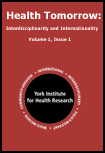A Content Analysis of Youth Sexual Health Websites: Exploring their Relevance and Accessibility for Youth with Disabilities
DOI:
https://doi.org/10.25071/2564-4033.37271Abstract
Because web-based campaigns are an important part of health promotion campaigns for youth, this research examines sexual health websites aimed at youth and explores the messages on HIV/AIDS for their relevance and accessibility for youth with disabilities. The researchers’ underlying understanding of disability is that it is socially constructed and that people with disabilities experience social exclusion. We used a directed content analysis method to analyze 21 websites that met our inclusion criteria based on our indicators of accessibility and relevance and for their key messages. We found that the messaging across all sites was highly consistent: sex-positive, gay-positive, and non-judgmental about youth sexual expression. However, none of the prevention information specifically considered mobility, verbal and cognitive disability, participation and information barriers faced by youth with disabilities, or their heightened sexual vulnerability. Only one site depicted disability in images and none depicted disability and sexuality. There is a clear need to better understand the sexual health information needs of youth with disabilities and to develop safe sex information that is relevant and accessible to them.

